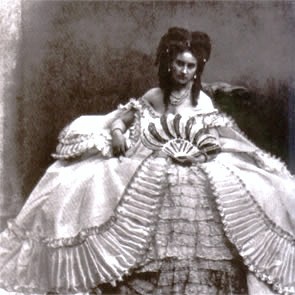|
TINTED/DYED MOTHER – OF – PEARL
|
|||
|
During some exhibitions of my fans many visitors have been impressed by some dyed mop brisé. They asked to me to speak about the various dye's techniques, reputing this particularity quite unusual.
I gather the occasion to give some informations on the matter, made even more exhaustive thanks to an article published on the FANA Forum of June 2007, with the collaboration of numerous members, such as Pierre-Henri Biger, M.me Céline Louvet of the Mother-of-Pearl Museum near Paris and Mr. Chuck Erikson.
The mop colouring techniques are still quite mysterious. The holders of this know-how communicated very little about this subject. These informations were covered by professional secret. Anyway, the dyeing was practiced after shaping the pbject, before a possible engraving or any other ornamentation and polishing finish.
There were used pigments of color, corrosive products (mordants) such as ammonia, and there was a hot process using a double boiler or a cold process in large earthware jars. Times of steeping were more or less long depending on the desired colors. For clear colors, it was initially necessary to carry out a discoloration of the mother-of-pearl, called “bleaching” with diluted hidrogen peroxide ( a little as for discoloring hair!!!)
Fan makers also used a shaded white mother-of-pearl, which has a nice silver tone and comes from the shell “amers des coquilles”, as in the splendid frame on Louis XVI wedding fan, encrusted with ciseled silver. However, none of these mother-of-pearls is as successful as the “nacre d'Orient”, called “Goldfish”, which has causeda revolution in the luxury fan industry in the last few years. In “Histoire de Eventails chez tous les Peuples et à toutes les Epoques – Librairie Renouard, Paris, 1875 – of Spire Blondel, we read od a certain Mr. Meyer who patented a process to dye the fans of this material. We believe the work of Meyer was a way of cutting the shell to make it iridescent not altering the natural colors, to make “Goldfish”. We haven't a description of the brevet, but we know he was able to give all the rainbow shades this remarkable product. He was assisted by Mr. Dumont-Brasseux in Andeville.
We know also some older methods of coloring nacreous shell:
SILVERING SHELLS
Silver-leaf and gum water a sufficient quantity; grind to a proper thickness, and cover the inside of the shells. For a gold color, grind-up gold-leaf with gum water, and apply to the inside of the shells.
TRUE GOLD POWDER
Put some gold-leaf, with a little honey, or thick gum-water made with gum Arabic, into an eathern mortar, and pound the mixture till the gold is reduced to very small particles; then wash out the money or gum repeatedly with warm water, and the gold in powder will be left behind. When dry, it is fit for use.
GENERAL DIRECTIONS FOR BRONZING
The choice of the above powders is,of course, determined by the degree of brilliancy you wish to obtain. The powder is mixed with strong gum-water or isinglass, and laid on with a brish or pencilk; and, when not so dry as to have still a certain clamminess, a piece of soft leather wrapped round the finger is dipped in the powder, and rubbed over the work. When the work has been all covered with the bronze, it must be left to dry, and any loose powder then cleared away by a hair-pencil. “The English and American Mechanic”, B. Frank Van Cleve, 1874.
TO DYE MOTHER-OF-PEARL WITH ANILINE COLORS
Wash the thin plates with lukewarm solution of potash, then place them in a concentrated aqueous solution of the coloring matter, and let them stand in a warm place, frequently stirring them. If the dye is to penetrate to some depth the plates must remain in the coloring matter for two weeks, then be rinsed and dried. “The techno-Chemical Receipt Book” Winckler, Elsner, Heintze, Mierzinski,Jacobsen,Koller, Heinzerling,Brannt and Wahl, 1886
TO COLOR SHELLS
Dissolve a little lac dye in a solution of chloride of tin; and having made the shells thoroughly clean, dip them in this preparation until they are of the desired color. The dye should be first boiled, and then allowed to stand to settle. “Encyclopedia of Pratical Receipts and Processes”, William B. Dick, 1903
IRIDESCENT
The following is said to be the process used in the Vienna shell button works. In a wide-mouth jar large enough to hold the shells, and fitted with a ground glass stopper, put as much ammonia water as will cover the shells. To this add silver chloride in powder until the liquid becomes saturated and a slight excess of the silver salt is established. Into this put the shell and, applying the stopper, set aside in a dark place for a few days. The play of colors is usually established in a few hours, but its permanency is made surer by a little longer exposure to the sun. As a general rule, one week's contact with the ammonia water, with two days' exposure to the direct light, are all-sufficient. “Scientific American Cyclopedia of Formulas,”edited by Albert A. Hopkins,1910.
|
|||

